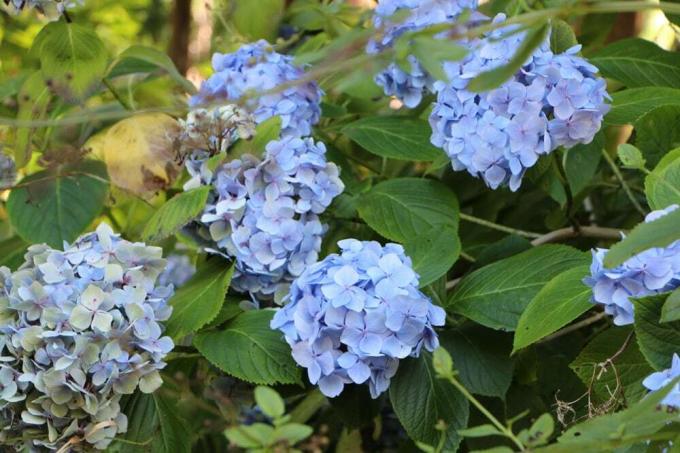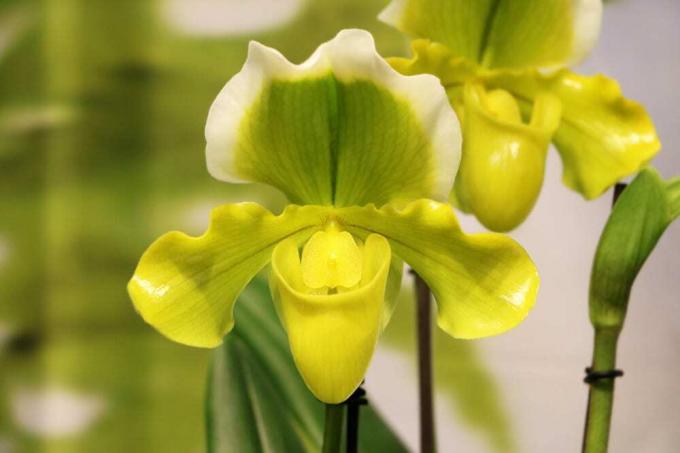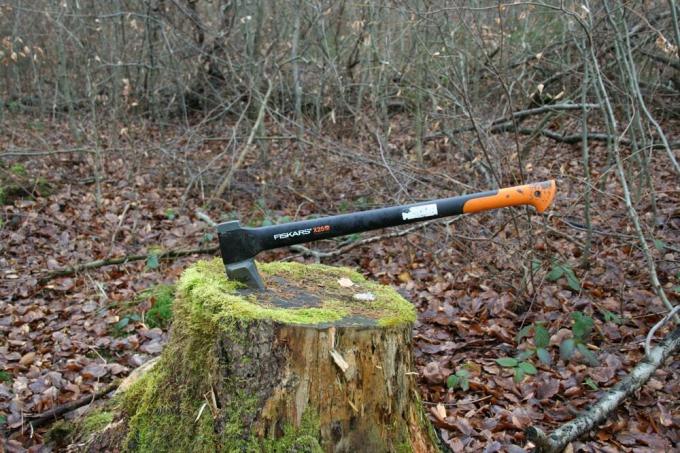

Table of contents
- substrate
- dryness
- lime
- wetness
- nutrient deficiency
- nitrogen deficiency
- iron deficiency
- fertilization
- pests and diseases
- spider mites
- leaf spot fungus
- cold
- prevention
- Conclusion
Hydrangeas are the blooming focal point in many gardens. The flowers shine in many shades - from white to soft pink and intense pink to blue - and thus attract many eyes. They also bring colorful variety to the garden or balcony. When hydrangeas shed leaves and flowers, they quickly become a sad sight. With the right countermeasures, however, the underlying causes can usually be remedied quite easily.
substrate
Hydrangeas have very high demands when it comes to the substrate. It must be loose and fibrous, but also be able to store water well and not compact or become waterlogged. For this, the plants need an acidic pH value of 4 to 5.5 - depending on the color of the flowers.
Therefore, when the hydrangea sheds leaves and flowers, the first thing to think about is a problem with the substrate. It is advisable:
- to test the pH
- to check the condition
- carry out a soil change if necessary
Regular repotting is urgently needed, especially with tub culture. Hydrangeas should not be in the same soil for more than two years.
Tip:
If you are unsure about the choice of substrate or the mixture, you can use special soil for hydrangeas and azaleas from specialist retailers. This meets all the requirements of the plants.
dryness
Hydrangeas have a high water requirement. Regular watering is particularly important during the growth phase and especially during the flowering period. If the leaves hang, they appear limp and withered, the substrate should be checked. At most, the top layer should be dried out and crumbly.
After that, the soil should appear moist. This cause of leaf and flower loss is very easy to fix as it simply requires more watering. If dryness occurs again and again, a few simple tips can prove useful:
- switch to substrate that retains moisture better
- Apply bark mulch to the soil
- Cover the substrate with stones or garden foil
These measures reduce evaporation and keep the soil moist for longer. If you then pour it in a floating manner so that the substrate can really soak up water, you can prevent drying out and the loss of leaves and flowers.
lime
Hydrangeas like a slightly acidic substrate and should therefore only be watered with soft - i.e. low-lime - water. Rainwater and stagnant tap water are ideal. If this has not been observed before, the plant can also shed leaves and flowers as a result.
The appropriate countermeasures consist of changing the substrate and using rainwater in the future. If it is difficult to change the substrate, acidifying fertilizers can also be used. In heavy, compacted soils, sulfur and iron sulphate can be used. Coffee grounds are also suitable for slightly acidifying the substrate.

In loose soils, organic agents can be used more often. Compost and rotted oak leaves are particularly suitable. During these measures, the pH value of the soil should be measured repeatedly to check the success and to avoid acidification. It is also important to work the chosen agent evenly and thoroughly into the surface of the substrate and then pour it well.
wetness
Although hydrangeas need a lot of water, the plants do not tolerate waterlogging. Care should therefore be taken very carefully in the bucket to ensure that the plant does not stand in water. Planted freely in the garden, control becomes a little more difficult. However, a small excavation can shed some light.
In the case of soil that tends to compact and substrate components that can store a lot of liquid, not only the watering should be suspended. Additional loosening material should be introduced here. Among other things, the following are recommended:
- Quartz sand, this improves water drainage
- coconut soil
- perlite
- sand
How much of it has to be added depends on the initial state of the substrate. It can also make sense to put a drainage layer of potsherds in the bucket.
nutrient deficiency
If a nutrient deficiency is responsible for the shedding of leaves and flowers, this is usually due to an undersupply of iron or nitrogen. However, both are relatively easy to identify and fix.
nitrogen deficiency
If there is a nitrogen deficiency, the older leaves will turn yellow first. This means that the plant yellows from the bottom up and from the inside out. A nitrogenous fertilizer can help here. If it is given over the substrate, the balance can take several weeks. It is therefore particularly suitable when yellowing and leaf shedding have not progressed too far.
On the other hand, if it has to be done quickly because the plant is already showing significant losses, a foliar fertilizer should be used. In this form, the nutrients are absorbed in a much shorter time, since they do not have to take the "detour" via the roots.
iron deficiency
Yellowing of the leaves is also typical of iron deficiency. Here, however, the leaf veins are still green. This condition is called chlorosis. After discoloration, the hydrangea sheds leaves and flowers. Here, too, action should be taken quickly.
Suitable antidotes are:
- iron chelate
- iron fertilizer
- blood meal

In addition, if there are signs of an iron deficiency, care should be taken to ensure that the pH value of the substrate is in the acidic range. Otherwise, the absorption of nutrients and minerals can be difficult.
fertilization
Apart from the deficiencies mentioned, the hydrangea can also be undersupplied in general. The right fertilization helps here. It is particularly easy to use special hydrangea fertilizer. The manufacturer's instructions should be followed for this. In the tub culture, part of the nutrient supply can also be ensured by regularly changing the substrate. Replacement every one to two years is ideal. If the soil is of poor quality, it should be changed every year.
pests and diseases
In the hydrangea, spider mites and the leaf spot fungus are primarily responsible for shedding flowers and leaves. In both infestations, the leaves will mottle and eventually turn brown before dropping. In addition, the plant is generally weakened, so that the loss of flowers is foreseeable. Here, too, it makes sense to act quickly against the infestation in order to limit the damage to the hydrangea and also prevent the fungi and pests from spreading to other plants.
spider mites
The leaves turn brown and often curl up. Greasy streaks and woven webs are visible. An infestation with spider mites is relatively easy to spot if you look closely. Fighting it is not quite as simple, but requires a little more effort. The affected leaves should be cut off or collected and destroyed or disposed of with household waste. In order to prevent further damage, appropriate means should be used immediately.
Spider mites are one of the most difficult parasites to control - it has to be The destruction of the leaves and the use of the chosen means were comprehensive and thorough become. It also helps to check culture conditions. The spider mites like it dry and warm. Occasional spraying has a preventative effect in very dry locations.
leaf spot fungus
The leaf spot fungus should be treated in the same way as the spider mites. Destroy infected leaves to prevent further spread. Leaves that have already fallen should also be collected and disposed of accordingly.
A fungicide must also be used. It also helps to check the site for suitability. If the hydrangea is in a very humid environment and particularly windless, the fungi have an easy time.
cold
Frostbite is not uncommon for hydrangeas. If shoots were exposed to sub-zero temperatures, they not only shed leaves as a result, but die off completely. Exceptions here are particularly frost-hardy varieties, such as individual panicle hydrangeas - these can easily withstand temperatures down to -30 °C. For everyone else, frost protection from brushwood, straw and garden fleece or bringing them indoors is mandatory.
prevention
If deciduous hydrangeas shed leaves and flowers outside of autumn, this is always an indication that care is not optimal. In any case, it makes sense to check all influences and adjust them if necessary. The following points can help:
- Check location for suitability, neither too dry nor too humid
- Examine the substrate and test the pH value
- Check the moisture of the substrate
- regular visual inspections of the plants
- use low-lime water
- fertilize regularly
- change the substrate at least every two years in pot culture
Conclusion
When hydrangeas shed leaves and flowers, quick action is required. Although the causes are usually relatively harmless, they still require appropriate countermeasures. The best prevention is to strengthen the plants through optimal culture conditions.
 garden editorial
garden editorial I write about everything that interests me in my garden.
Learn more about plant care

Prick radishes: Instructions | How to increase the harvest
Pricking out is a common horticultural practice that is particularly important when growing radishes. If the plants are too close together, they cannot develop. With the right approach, separation becomes child's play.

Fertilize orchids - when, how and with what? The top 10 fertilizers
Orchids are the ideal eye-catcher for the windowsill, the balcony and in the garden. Because of the plant family's unique diversity, many gardeners wonder how fertilizing the Orchidaceae works to provide the flowers with the right nutrients.

Plants with white mold on leaves - this helps
White mold on leaves occurs both in the garden and on indoor plants. Mold growth can have various triggers and causes. This white coating often forms when it has rained for a long time or when indoor plants have been given too much water. With the right approach, further spread can be prevented in the long term.

Remove tree stump / have it milled - costs + prices of the root cutter
An unwanted tree stump can be removed in a number of ways, although using a stump grinder is usually the best way to do this. Here you can find out how this device is used and what needs to be taken into account when using this method!

Kumquat sheds leaves/flowers - which helps the kumquat tree
There are various reasons why a kumquat tree loses its leaves and flowers. In winter, leaf loss is rarely a cause for concern, but appropriate countermeasures should be taken in summer, otherwise the tree will quickly become bare. In this context, the temperature, the light and the casting units must be checked in particular.

Build your own rhizome barrier for bamboo & co – alternatives
Plants with rhizomes, i.e. roots that spread underground from which new plants grow elsewhere, can quickly spread throughout the garden bed and to the neighbor. To prevent this from happening in the first place, rhizome barriers should be used around the plant, for example the popular bamboo, which the hobby gardener can also build himself.


